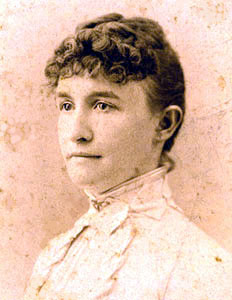
Mary Noailles Murfree ("Charles Egbert Craddock")
In the latter part of the nineteenth century, Mary Noailles Murfree depicted the scenery and people of the Tennessee mountains for a national audience. At a time when local color fiction was much in vogue throughout the country, she came to prominence as the most noted writer using the southern mountains as the setting for her fiction.
Murfree was born in Murfreesboro, the name of the city having been changed to honor an ancestor of hers. When she was seven, the family moved to Nashville, where she attended the Nashville Female Academy and lived for the next sixteen years. In 1867, shortly after the end of the Civil War, she attended the Chegary Institute in Philadelphia, a “finishing school” for young women.
The Murfrees owned a cabin at Beersheba Springs, a summer resort in the Cumberland Mountains south of McMinnville, and for about fifteen years Murfree went there every summer with her family. Much of what she knew of mountain scenery, speech, and manners apparently came from those summers at Beersheba, though she also visited Montvale Springs, south of Maryville, and ventured into the Smoky Mountains as far as Gregory’s Bald.
Though their Murfreesboro home, Grantland, was destroyed during the Civil War, a new house was built, and in 1872 the family moved there, remaining until 1881, when they moved to St. Louis. By that time Murfree had published a number of stories, beginning in 1874-75 with “Flirts and Their Ways” and “My Daughter’s Admirers,” which appeared under the pseudonym “R. Emmet Cembry.” In 1878 the prestigious Atlantic Monthly published her story “The Dancin’ Party at Harrison’s Cove,” set at a summer resort modeled on Beersheba Springs. This time she used a different masculine pseudonym, “Charles Egbert Craddock,” and it was by that name that she became widely known.
Murfree’s first book was In the Tennessee Mountains (1884), a collection of eight stories set in either the Cumberlands or the Great Smokies. All had previously appeared in the Atlantic Monthly. In the following year Murfree published her first mountain novel, The Prophet of the Great Smoky Mountains. Between the two there appeared Where the Battle Was Fought (1884), set at Murfreesboro.
For years readers had been curious about the identity of the mysterious “Craddock.” The Boston editors and publishers with whom she corresponded knew the author only as “M. N. Murfree,” the signature on her letters to them. They assumed that the writer was male. The secret was at last revealed in 1885, when Murfree, her sister, and her father journeyed to Boston to meet with an astonished Thomas Bailey Aldrich, editor of the Atlantic Monthly.
In the years which followed Murfree published many more books, twenty-five in all, most of them about the mountains, but some focusing on Tennessee history and on the Cherokee Indians. Some of her later fiction was set in Mississippi. By 1891 she had returned to Tennessee, where she lived the rest of her life, dying at Murfreesboro in 1922. Her last novel was printed posthumously in the Nashville Banner.
Murfree’s fiction has been consistently criticized for its stereotyping of the mountaineer and for its overblown, highly romanticized descriptions of the landscape. Almost every reader notices the wide gap between the tone and vocabulary of the narrator and the mountain dialect of her characters. Like many other local color writers, she felt it necessary to provide as narrator a cultured, sophisticated intermediary, someone like the reader she hoped to reach.



